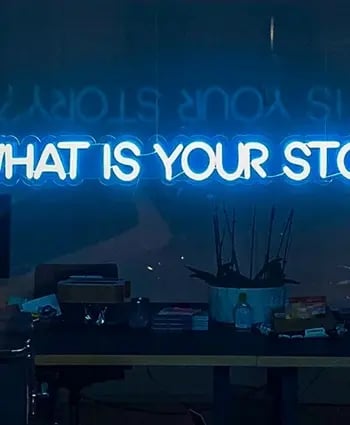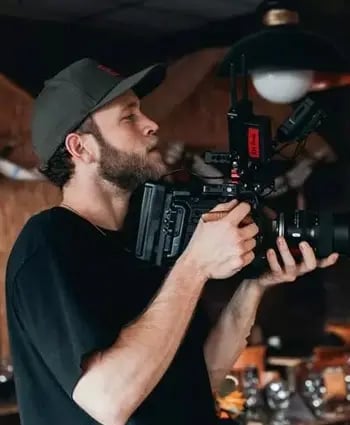Why You Need Video Marketing: 3 Common, Achievable Goals
Without a video marketing strategy you're not making the most of your video content. Here's why you should use video marketing to achieve your goals.
 Imagine creating an incredible piece of marketing content.
Imagine creating an incredible piece of marketing content.
It could be a blog post or a podcast. Whatever it is, it's informative, unique and useful.
You know your target audience will love it.
But instead of sharing it with them, you just let it sit and stagnate on your website, in the hopes that they'll find it by themselves.
Crazy, right?
Yet it's something a surprising amount of us are guilty of when it comes to video.
It's why video marketing is so important to reaching your goals.
Achieving Success with Video Marketing
To get the most from your video content you need an effective video marketing strategy.
And if you're not already using video as part of your wider marketing efforts, you're missing out.
This blog post will explain why. I'll guide you through what video marketing is, why you need it, and show exactly how it can achieve 3 of the most common marketing goals with simple examples.
-Oct-17-2022-09-40-27-03-AM.png?width=156&name=Video%20Fundamental%20Guide%20Thumbnail%20(1)-Oct-17-2022-09-40-27-03-AM.png) 5 Fundamentals of Video Content Planning
5 Fundamentals of Video Content Planning
Learn the key steps to planning engaging & effective video content.
Packed full of our expert advice on how to create a video strategy, set SMART objectives, and generate the best possible video ROI.
First of All, What is Video Marketing?
We need to get ourselves on the same page.
That's because there are really two things that video marketing can refer to:
- Using video content as part of your whole marketing strategy, aka. 'video marketing'.
- Using marketing techniques to improve the results of your video content, aka. 'marketing a video'.
At first they might appear like two different things, but really these definitions of video marketing are two sides of the same coin.
By incorporating video into your marketing strategy, you'll also plan out how to market those specific videos.
And by marketing your video content, you are by definition working within your marketing strategy.
So keep both of these meanings in mind. When we speak about video marketing, we're really talking about both of them.
Why Do I Need Video Marketing?
There are many reasons why video is an integral part of any successful marketing strategy.
I'll cover 3 of the most important ones here.
Video is Effective and Has Great ROI
(When it's marketed well, that is.)
A successfully marketed video with a strong video marketing strategy behind it is one of the most effective types of content in the world.
That's why 52% of marketing professionals say video has the best ROI of all content types.
When BrightRoll surveyed over 150 advertising executives, it found:
- 91% believe video is equally or more effective than display advertising.
- 75% believe video is equally or more effective than TV.
- 68% believe video is equally or more effective than social media.
And in a study by ITN Productions, 82% of brands said they considered their previous investment in video either successful or very successful.
Your Audience Watches Video, Your Competitors Use Video
Video is an enormous part of the online and social conversation nowadays.
If you're not using it in your marketing, I can guarantee you're missing out on reaching potential customers and a large segment of your target audience, no matter your industry or size.
There are 100 million internet users who watch online video every day. That's a massive pool of people, including men, women, teenagers, the elderly, teachers, plumbers, and lawyers. Some of those people will represent your market.
But it's not just B2B companies who can benefit from video. Forbes found that 75% of executives watch work-related videos on business websites at least once a week.
Finally, video content is so ubiquitous that your competitors are almost certainly using it.
A massive 91% of marketing executives now use online video content in their marketing. If you're not incorporating video into your marketing strategy, you may well be slipping behind others in your industry who do.
Video Helps to Achieve Your Marketing Goals
Most importantly, you need video marketing because it'll help you to achieve your objectives.
For many of the most common marketing goals, video is the most effective and efficient way to reach them.
Here are a few statistics to help illustrate the power of video to achieve great things:
- The average user spends 88% more time on a website with video.
- 80% of internet users recall watching video ads on the sites they visited in the past 30 days.
- Of that 80%, 46% took some action after viewing the video.
- Video content on landing pages can increase conversion by 80%.
- Visitors to retail sites are 64% more likely to purchase if they watch video first.
- Including video in an introductory email can improve click-through rates by 96%.
- It can also reduce the number of subscriber opt-outs by 75%.
3 Common Goals Achievable With Video
Now let's turn to 3 of the most common marketing goals and examine in detail how video marketing is best suited to achieve them.
I'll explain each goal, pick out the KPIs associated with it, and outline an example video marketing strategy that could be used to reach them.
Let's get started.
 1. Brand Awareness
1. Brand Awareness
Brand awareness is always an important and popular marketing goal.
Why? Because the more people are aware of your brand, product or service, the larger your pool of potential customers.
Before you can convert and close, everything comes back to making sure your target audience know who you are. It comes back to brand awareness.
KPIs associated with this goal:
Unfortunately, it can be difficult to track brand awareness.
Often this is done by measuring brand recall and recognition, or a brand's rate of appearance in the media and on social media. These statistics can all be used to measure the success of video content.
However, for the purposes of this post let's measure brand awareness with a much simpler metric: video views.
(Feeling confused about video metrics? Check out my blog post on the topic.)
The more views your video content receives, the more times it's been watched. This metric doesn't give us a lot of insight, but it does give us a raw indication into how popular a video is, its reach, and how successful it has been at spreading awareness of our brand.
The video marketing strategy:
A successful video marketing strategy should plan both the video content itself and how it is distributed.
First, we need to decide what type of video content will be best suited to achieve our goal.
For an aim of increasing brand awareness, our video content should:
- Be useful and/or interesting shareable content for our target audience.
- Get across a strong emotion, whether that's awe, inspiration, joy or humour.
- Include elements of our brand, without overloading the audience with information.
- Be short and succinct.
Here's a great video that succeeded at increasing Elan Language's brand awareness:
Next, we plan how the video will reach our audience.
When you're trying to gain the largest reach possible, it can be tempting to put your video content in as many places as possible.
But brand awareness is never about awareness for the sake of it. It's about awareness in the right people, in your target audience.
That's why a successful video marketing strategy with the goal of brand awareness will still focus on placing your video content in the right place, at the right time, in front of the right people.
Here's an example distribution strategy that would fulfil those criteria:
- First, share your video content widely with your followers on social media. Be sure to share it at the right time for your audience and enough times to maximise your reach.
- Also make your target audience's key influencers aware of the video content, and encourage them to share it with their followers too.
- Place your video on relevant content sharing websites where your audience spends their time (but pay attention to the sites' specific rules and customs). Try Digg, Stumbleupon and Reddit.
- Use PR to focus on an interesting aspect of your video content and spread it widely to those in your target audience you wouldn't otherwise reach.
- Consider using paid video ads to place your video in front of hundreds or thousands of targeted viewers.
- You could even run a competition based on your video, requiring viewers to watch and engage with your content in some way to enter. Share that on social media too!
Why video is the best content for the job:
When you're looking to maximise brand awareness, you want your video content to be shared as much as possible so its reach is increased exponentially.
It turns out that videos are shared 1200% more than links and text posts combined on Facebook. (Unsurprisingly, video is also the most shared content type on the channel.)
Video sees similarly high rates of sharing across social media. And 92% of those who watch videos on mobile devices share them with others.
No other type of content has as much sharing potential as video. If your goal is to maximise your brand awareness, video should be your first choice.
 2. Lead Generation and Conversion
2. Lead Generation and Conversion
Getting your brand noticed is great, but by itself it's difficult to track its impact on your sales figures.
When it comes to generating and converting leads however, marketing can have much more influence on the total number of paying customers.
By focusing on generating leads, you're increasing the amount of interested people in your target audience who may one day buy from you. And by converting those leads, you're actually turning them into customers.
KPIs associated with this goal:
These ones are pretty obvious. To work out how many leads a video has generated, you generally just count them. You can then turn that number into a percentage or ratio of views to leads if you wish.
As for lead conversion, this is usually shown through a conversion rate, which expresses a percentage of all viewers that convert.
The most difficult part about this metric is working out how exactly you'll measure it.
Strangely enough, it can mean very different things to different people. A conversion can count as a subscription, a form submission or a purchase, depending on the situation. (A purchase is the most common meaning.)
Plus, the number you generate can vary depending on your attribution model. This model alters how much your video counts towards the conversion of the viewer, depending on when in the lifecycle they watched it. If this all sounds very confusing, read up more on it here.
For this post we'll assume you've cleared all these issues up and are using the number of leads and your conversion rate problem-free to measure lead generation and conversion on your video.
The video marketing strategy:
When our goal is to generate and convert leads, we need a different type of video content than when focusing on brand awareness. It should concentrate more on informing the viewer about how we can help them and why they should convert.
For this aim, our video content should:
- Answer our target audience's particular needs or problems.
- Give specific information about the offer, product, service or brand in question.
- Be as short as possible while still getting across all the necessary information.
Take a look at this example of a successful piece of video content for converting leads:
Now we know the kind of video we need, let's work out how to reach our audience with it.
For lead generation and conversion you'll want to aim for a much more specific type of viewer than for general brand awareness. You want people in your target audience who are thinking about converting or who might one day think about converting.
(Otherwise you're just filling up your funnel with useless leads!)
That means a much more tailored and targeted distribution strategy for your video content.
Something like this would work:
- Design a specific landing page for your video to sit on that encourages viewers to take the desired action (either via forms or calls-to-action).
- Optimise that landing page, and your video content, to rank on search engines for a relevant keyword(s). A transcript or summarisation of your video on the page will help.
- Use the video in an email campaign to existing leads, being sure to include a call-to-action leading them to convert.
- You could also use paid video ads to reach your target audience on the sites they frequently visit.
Why video is the best content for the job:
Our end goal is to generate leads and convert them to customers.
Video content is uniquely able to build trust and increase conversions, thanks to its visual nature (we humans trust things we can see with our own eyes) and its ability to engage your audience.
Studies have shown that video content on landing pages can increase conversion by 80%.
Not only that, but visitors to retail sites are 64% more likely to purchase if they watch video first.
That's why more than 70% of marketing professionals report that video converts better than any other type of content.
 3. Viewer Engagement
3. Viewer Engagement
Engagement might seem like a bit of a non-metric, but it's actually incredibly important and insightful.
By focusing on viewer engagement as your goal when producing and marketing video content, you can commit to encouraging the loyalty and support of your target audience, leads and customers.
When your target audience appreciates and engages with the video content you produce, you've unlocked a powerful force to compel them to convert more quickly and frequently.
KPIs associated with this goal:
Not surprisingly, when measuring viewer engagement we track the average engagement metric.
This metric is a percentage that tells you how much of your video all viewers watched, on average. It is most usefully displayed in an engagement graph showing how your audience as a whole watched, re-watched and stopped watching your video.
It's not only our raw viewer engagement that we'll want to measure.
With engagement graphs we can also gain insights into our target audience and understand how useful or interesting they found the video content.
This information can empower us to create even more engaging and successful videos in the future.
(There are also alternative ways of tracking engagement, including the number of comments and amount of discussion your video receives.)
For now, let's focus on average engagement as our main KPI for this goal.
The video marketing strategy:
If engagement is your major focus, you should be creating the most valuable and compelling video content possible for your audience.
To do this we need video that:
- Hooks your audience quickly and compels them to keep watching to the end.
- Offers viewers something worthwhile, useful and emotionally engaging.
- Is clear and straight to the point.
- Is short, visually exciting, and easy to consume.
Below is a video from advertising agency John St. that embodies all of these points:
Because our aim with this video content is to increase engagement in our audience, we won't necessarily be spreading it to as many viewers as possible.
What we want to do is make sure our video reaches our target audience, who are most likely to engage with its message and content. The focus is on a highly involved and interested base of viewers.
So we need a distribution strategy like this:
- Share your video content with relevant communities online where your target audience spends time and enjoys similar content. Do this by engaging as a real individual, as yourself.
- Pick key influencers of your target audience and share your video publicly with them, asking for feedback or just whether they enjoyed it.
- Allow comments on your video content wherever it is placed. You want to encourage discussion, and most importantly, be involved in it.
- Continue to create engaging video content on a regular schedule (it's less vital to be frequent, as long as it's regular), and make sure to always share it via your core channels.
- Plus, don't forget to share your videos on social media. This can be a very effective place to build your own community of engaged viewers.
Why video is the best content for the job:
When it comes to audience engagement, there's really no type of content better than video.
It basically boils down to biology. We humans are hard-wired to pay attention to video. Vision is our dominant sense, which gives us a predisposition to visual types of content. We interpret images in under 1/10th of a second.
Add movement and sound into the mix, and video becomes something that's very difficult to ignore. We're irresistibly drawn to it.
Not only that, but video content is highly personal, emotional and persuasive.
Just think about the difference between reading a person's ordeal and watching them retell it, hearing their voice waver and seeing the fleeting expressions on their face as they relive the experience.
Video content gives you the chance to create a visual, aural and emotional connection with your audience. That's an ability offered by no other type of content.
Round-up: Achieving Your Goals with Video Marketing
So that's why you need video marketing, and how a good video marketing strategy can help you achieve some of the most common marketing goals.
No matter your aims, take the time to consider and plan out how you'll market your video content so you can achieve the results you want.
I'll leave you with some final distribution tips for other goals you may want to reach with video:
- Increase your social reach: make your video content easy to share on social media, and encourage your existing followers to do so. Post consistently great content.
- Increase traffic to your site: create a strong call to action for your video content, then place it on every relevant channel where your target audience spends their time.
- Reach a new audience: do lots of research into your new audience and discover how and where they watch video. Reach out to key influencers and consider using paid video ads to gain traction.
-Oct-17-2022-09-40-27-03-AM.png?width=156&name=Video%20Fundamental%20Guide%20Thumbnail%20(1)-Oct-17-2022-09-40-27-03-AM.png) 5 Fundamentals of Video Content Planning
5 Fundamentals of Video Content Planning
Learn the key steps to planning engaging & effective video content.
Packed full of our expert advice on how to create a video strategy, set SMART objectives, and generate the best possible video ROI.
Written by Jonathan English CEO for Venture Videos — a full-service video production agency that specialises in producing creative videos & campaigns that get real results.




